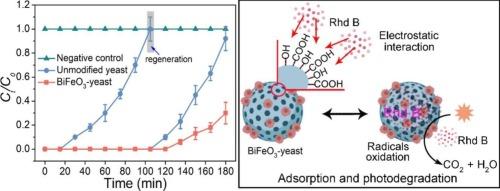BiFeO3纳米颗粒功能化酵母复合材料增强罗丹明B的吸附和光降解:合成、性能和机理
IF 6.3
2区 工程技术
Q1 ENGINEERING, CHEMICAL
引用次数: 0
摘要
纺织和印刷业产生的染料污染物会造成严重的水污染。因此,水处理过程中使用的吸附剂必须具有低成本、高去除效率和良好的再生性能。在这项工作中,我们首次报道了功能化商业面包酵母(BiFeO3-yeast)纳米粒子的制备方法,它是一种有效的生物吸附剂,在静态批处理和动态柱处理两种条件下,具有去除罗丹明 B(Rhd B)的优异光催化再生活性。通过扫描电镜、电致发光、XRD、TGA、傅立叶变换红外光谱和 XPS 等不同仪器对成功合成的复合 BiFeO3-酵母进行了表征。对各种吸附条件(如吸附时间、环境温度和初始 Rhd B 浓度)的影响进行了深入评估。BiFeO3- 酵母复合材料的 Rhd B 吸附能力(59.42 mg/g)高于未改性酵母(20.47 mg/g),其单层吸附过程主要归因于物理和化学相互作用的结合。研究还表明,BiFeO3-酵母在可见光下具有良好的吸附-光降解和可回收性(四次吸附-解吸循环后吸附容量损失为 20%)。傅立叶变换红外光谱和 XPS 分析以及吸附-光降解测试表明,碱性水热合成条件下产生的表面含氧官能团和引入的光催化剂 BiFeO3 纳米粒子协同参与了 BiFeO3- 酵母复合材料对 Rhd B 的吸附-光降解过程。总之,研究结果表明,BiFeO3-酵母复合材料有望通过吸附光降解去除染料。本文章由计算机程序翻译,如有差异,请以英文原文为准。

Enhanced adsorption and photodegradation of rhodamine B by BiFeO3 nanoparticles functionalized yeast composite: Synthesis, performance, and mechanism
Dye contaminants from textile and printing industries can cause severe water pollution. Low cost, high removal efficiency, and good regeneration properties are thus highly required for the employed adsorbents in the water treatment process. In this work, for the first time, we report the fabrication of BiFeO3 nanoparticles functionalized commercial baker's yeast (BiFeO3–yeast) as one of the effective biological adsorbents with excellent photocatalytic regeneration activity for rhodamine B (Rhd B) removal in static batch and dynamic column two conditions. The successful synthesis of composited BiFeO3–yeast was characterized by different instruments including SEM, EDS, XRD, TGA, FT-IR, and XPS. Effects of various adsorption conditions, such as adsorption time, environmental temperature, and initial Rhd B concentration were evaluated thoroughly. The BiFeO3–yeast composite displays a higher Rhd B adsorption capacity (59.42 mg/g) than unmodified yeast (20.47 mg/g), and its monolayer adsorption process has mainly attributed to the combination of physical and chemical interactions. It is also shown that BiFeO3–yeast possesses good adsorption-photodegradation and recyclability under visible light (<20 % of adsorption capacity lost after four adsorption-desorption cycles). FT-IR and XPS analysis combined with adsorption-photodegradation tests demonstrate that generated surface oxygen-containing functional groups in alkaline hydrothermal synthesis conditions and introduced photocatalyst BiFeO3 nanoparticles synergistically participated in the adsorption-photodegradation of BiFeO3–yeast composite for Rhd B. The column test further evidence that BiFeO3–yeast is effective in the removal of Rhd B in flow condition. Overall, results show that the composited BiFeO3–yeast is promising for dye removal through adsorption-based photodegradation.
求助全文
通过发布文献求助,成功后即可免费获取论文全文。
去求助
来源期刊

Journal of water process engineering
Biochemistry, Genetics and Molecular Biology-Biotechnology
CiteScore
10.70
自引率
8.60%
发文量
846
审稿时长
24 days
期刊介绍:
The Journal of Water Process Engineering aims to publish refereed, high-quality research papers with significant novelty and impact in all areas of the engineering of water and wastewater processing . Papers on advanced and novel treatment processes and technologies are particularly welcome. The Journal considers papers in areas such as nanotechnology and biotechnology applications in water, novel oxidation and separation processes, membrane processes (except those for desalination) , catalytic processes for the removal of water contaminants, sustainable processes, water reuse and recycling, water use and wastewater minimization, integrated/hybrid technology, process modeling of water treatment and novel treatment processes. Submissions on the subject of adsorbents, including standard measurements of adsorption kinetics and equilibrium will only be considered if there is a genuine case for novelty and contribution, for example highly novel, sustainable adsorbents and their use: papers on activated carbon-type materials derived from natural matter, or surfactant-modified clays and related minerals, would not fulfil this criterion. The Journal particularly welcomes contributions involving environmentally, economically and socially sustainable technology for water treatment, including those which are energy-efficient, with minimal or no chemical consumption, and capable of water recycling and reuse that minimizes the direct disposal of wastewater to the aquatic environment. Papers that describe novel ideas for solving issues related to water quality and availability are also welcome, as are those that show the transfer of techniques from other disciplines. The Journal will consider papers dealing with processes for various water matrices including drinking water (except desalination), domestic, urban and industrial wastewaters, in addition to their residues. It is expected that the journal will be of particular relevance to chemical and process engineers working in the field. The Journal welcomes Full Text papers, Short Communications, State-of-the-Art Reviews and Letters to Editors and Case Studies
 求助内容:
求助内容: 应助结果提醒方式:
应助结果提醒方式:


